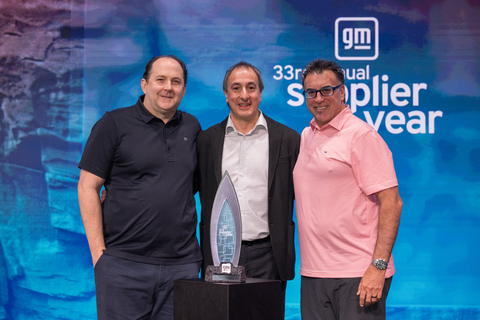
Chrysler Group Chief Operating Officer Eric Ridenour gave industry leaders an overview of the company’s multi-pronged powertrain strategy which focuses on applying technological lessons and processes learned from its innovative World Engine plant. The strategy also includes identifying opportunities for better fuel economy and alternative fuel choices. He spoke today at the annual Management Briefing Seminars in Traverse City, Michigan.
Ridenour told the group that the entire Chrysler Group leadership team is “firmly committed to being competitive in all vehicle segments. We believe we have a sound strategy in place, the right products in the pipeline and the right people guiding our business to ensure we’re prepared for the coming challenges.”
Chrysler Group is launching 10 new vehicles this year, a company record. The vehicles are fuel-efficient, and most are targeted to today’s hottest segments: cars and small SUVs. Ridenour noted that a key part of the product offensive is an intense focus on fuel efficiency, offering flexible-fuel vehicles (FFV) and a future powertrain strategy which includes a new V-6 engine program.
Chrysler Group is currently developing a business case for a new family of V-6 engines based on a single V-6 architecture. If approved, this one engine would replace four current Chrysler Group engine families while representing a major investment in three U.S. sites. This engine would be produced in a variety of displacements, built around an all-aluminum, dual-overhead cam, four-valve-per-cylinder design.
While the company is still developing its business case for the V-6 project, its Global Engine Manufacturing Alliance (GEMA) plant in Dundee, Michigan, is setting the foundation for future programs. “With GEMA, we were able to apply economies of scale to component and machine tool purchases to generate big savings that we were then able to invest back into the World Engine — allowing us to add features that improve performance, refinement, durability and affordability,” Ridenour noted.
He added that many of the technological lessons and processes learned at GEMA will be applied to any future engine architecture going forward. “We’re very confident that we would be able to achieve the same flexibility in a V-6 family as we have in our family of four-cylinder World Engines,” said Ridenour.
The future V-6 engine is only one part of the Company’s powertrain strategy — providing the highest possible fuel economy is another.
For example, four of the 10 all new vehicles coming out in 2007 will have better than 30 mpg highway mileage. Chrysler Group was the first to market modern cylinder de-activation with its Multi-Displacement System (MDS), in its HEMI(R) vehicles. MDS seamlessly alternates between smooth, high-fuel-economy four-cylinder mode when less power is needed, and V-8 mode when more power is in demand, and improves fuel economy by up to 20 percent. Ridenour added that more than $60 million worth of gasoline will have been saved through the end of the 2007 model year thanks to MDS technology.
“We have ‘fuel economy teams’ that go through each of our vehicles — piece by piece, ounce by ounce, joule by joule and amp by amp,” Ridenour explained. “Here’s an example: By optimizing our design, we were able to reduce the fuel pump amperage by about 40 percent. Since fuel pumps run all the time, this results in about 0.1 mpg savings on high-flow applications like flex-fuel and HEMI-equipped vehicles. No tenth-of-a-mile improvement is too small to consider in the battle for fuel efficiency.”
The third part of the company’s strategy is to provide vehicles that will help reduce our country’s dependence on oil through increased use of renewable fuels, such as ethanol.
“We believe that flexible-fuel vehicles are part of the answer and part of a complete lineup of options that our customers expect. Ethanol-based fuels like E 85 are a part of a viable long-term strategy for our nation’s energy security,” Ridenour explained.
Ten percent of Chrysler Group vehicles produced over the past eight years are flex-fuel capable — a greater percentage than any other company. Today, there are 1.5 million ethanol-capable Chrysler, Jeep(R) and Dodge vehicles on the road. In 2007, the company will produce 250,000 more E 85-capable vehicles, and in 2008, it will double that number to 500,000. However, the challenge is to educate the owners of those vehicles.
Ridenour announced that starting next year, the Chrysler Group will share an element of General Motors’ “Live Green, Go Yellow” campaign. The Chrysler Group will install bright yellow fuel caps on each of its FFVs which will allow consumers, at a glance, to know if their vehicle is flex-fuel capable. Additionally, the company will begin badging its FFV vehicles.
In addition to ethanol vehicles, Chrysler Group has been a leader in supporting biofuels. Each Jeep Liberty is fueled with B5 (5 percent biodiesel) at the factory and the program will continue with the 2007 Jeep Grand Cherokee CRD — the company’s first diesel-powered full-size SUV with a new 3.0-liter Mercedes-Benz engine. Going forward, the Chrysler Group continues to look for ways to leverage the diesel expertise of its sister division, Mercedes-Benz, to bring clean-burning diesels with superior fuel economy to consumers. Today’s diesel engines are up to 95 percent cleaner than the diesels of 15 years ago, and provide an average of 30 percent better fuel economy.
DaimlerChrysler also has its eye on future technologies including hybrids and fuel cells. Ridenour explained that a new two-mode hybrid system, developed with GM and BMW, leapfrogs traditional hybrid design by improving fuel economy by up to 25 percent. Chrysler Group will introduce this system with the Dodge Durango in 2008. And with more than 100 fuel cell vehicles on the road today — more than any other company — DaimlerChrysler is helping to speed the development of hydrogen-powered vehicles and promote customer familiarity.
“We are a full-line producer of vehicles, and we intend to compete in multiple powertrain technologies,” said Ridenour. “We know that each has its merits. That’s why we believe in a combination of biofuels, diesels, hybrids, fuel cells and advance gasoline technologies. No one technology will win the day. Bottom line is consumers want choice.
“Our customers will ultimately decide the technologies they want and need to power their vehicles — now and in the future. And DaimlerChrysler will be standing at the ready with all the options available to meet their needs,” Ridenour concluded.













More Stories
Speira brings research, politics and business case makers together
BRANO and DOMO join forces to replace aluminum with TECHNYL® polyamide
Selecting the Ideal Linear Phased Array Transducer for Your NDT Requirements